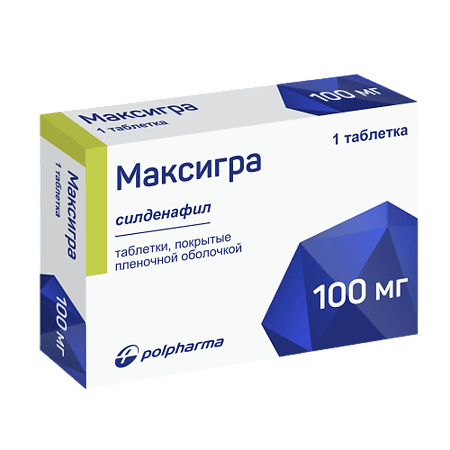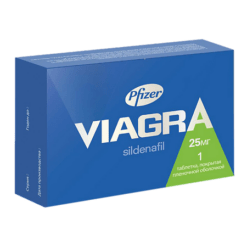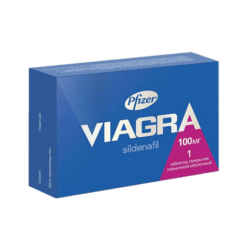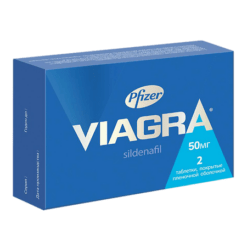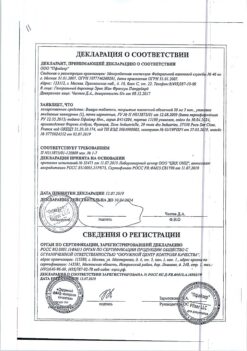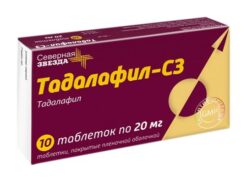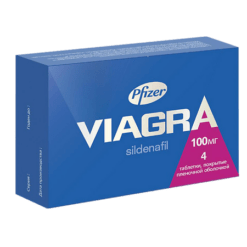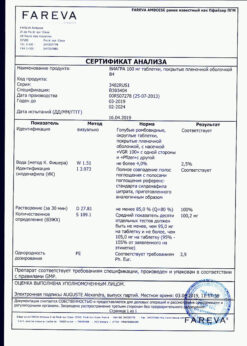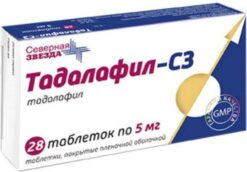No products in the cart.
Maxigra, 100 mg
€1.00
Out of stock
(E-mail when Stock is available)
Description
Pharmacotherapeutic group: Erectile dysfunction treatment – FDE5 inhibitor.
The ATX code: [G04BE03].
Pharmacological properties
Pharmacodynamics
Sildenafil is a drug for the treatment of erectile dysfunction. With sexual stimulation, it restores impaired erectile function by increasing blood flow to the penis.
Sildenafil is a potent and selective inhibitor of cGMP-specific phosphodiesterase type 5 (FDE5). Sildenafil has no direct relaxing effect on the isolated cavernous body, but actively enhances the relaxing effect of nitric oxide (NO) on this tissue by inhibiting FDE5, which is responsible for the breakdown of cGMP in the cavernous body. When the NO/ cGMP pathway is activated, inhibition of FDE5 under the influence of sildenafil leads to an increase in cGMP levels in the cavernous body, resulting in muscle relaxation and increased blood flow in the cavernous body. The pharmacological effect is achieved only in the presence of sexual stimulation.
The activity against FDE5 is 10-10000 times higher than activity against other FDE isoenzymes (1-11).
In clinical studies it has been shown that the average time to achieve an erection of 60% persistence (sufficient to perform sexual intercourse) was 25 minutes (range 12 to 37 minutes).
In some patients, a mild and transient impairment in color vision (blue/green) was detected 1 hour after taking the drug at a dose of 100 mg using the Farnsworth-Munsell 100 test; 2 hours after taking the drug, these changes were absent. Inhibition of FDE6, which is involved in the transmission of light in the retina, is thought to be the mechanism of color vision impairment. Sildenafil has no effect on visual acuity, contrast perception, electroretinogram, intraocular pressure, or pupil diameter.
In healthy volunteers there was no effect on sperm motility or morphology after a single sildenafil dose of 100 mg.
Pharmacokinetics
Intake
After oral administration sildenafil is rapidly absorbed. Absolute bioavailability averages 41% (range 2563%‑).‑ The maximum concentration (Cmax) in plasma with a single oral intake of 100 mg of the drug on an empty stomach is 18 ng/ml (38 nM) and is reached within 30-120 minutes (on average 60 minutes).
If sildenafil is taken with a fatty meal, Cmax is reduced by 20-40% and is reached after 1.5-3 hours.
Distribution
The volume of distribution (Vd) of sildenafil in equilibrium is on average 105 liters. Sildenafil and its main circulating N-desmethyl metabolite are approximately 96% bound to plasma proteins. Binding to proteins does not affect the total concentration of the drug.
In healthy volunteers receiving sildenafil (a single dose of 100 mg), less than 0.0002% (mean 188 ng) of the administered dose was detected in semen 90 minutes after administration.
Metabolism
Sildenafil is metabolized primarily by the hepatic microsomal isoenzymes CYP3A4 (major pathway) and CYP2C9 (minor pathway). The main circulating metabolite is formed from sildenafil by N-demethylation. This metabolite has a phosphodiesterase selectivity profile similar to that of sildenafil, and its activity against FDE5 in vitro is approximately 50% of that of the parent drug. The plasma concentration of this metabolite is approximately 40% of that of sildenafil. N-desmethyl metabolite is further metabolized, with a half-life (T½) of approximately 4 hours.
The total clearance of sildenafil is 41 l/h, and the T½ during the terminal phase is 3-5 h. After oral administration, sildenafil is excreted as metabolites primarily by the intestine (approximately 80% of the dose) and to a lesser extent by the kidneys (approximately 13% of the dose).
Pharmacokinetics in special clinical cases
Elderly patients
In elderly patients (over 65 years), sildenafil clearance is decreased and plasma concentrations of free active substance are about 40% higher than in younger (18-45 years) patients.
Patients with renal impairment
In mild (KC 50-80 ml/min) and moderate (KC 30-49 ml/min) renal impairment, the pharmacokinetic parameters of sildenafil are unchanged after oral administration once (50 mg).
In severe renal impairment (CKR ≤ 30 mL/min), sildenafil clearance is decreased, resulting in approximately twice the AUC (100%) and Cmax (88%) compared to those in normal renal function in patients of the same age group.
Patients with hepatic impairment
In patients with mild to moderate cirrhosis (Child-Pugh grades A and B), sildenafil clearance is reduced, resulting in increased AUC (84%) and Cmax (47%) compared to those with normal liver function in patients in the same age group.
Pharmacokinetic parameters of sildenafil in patients with severe hepatic impairment have not been studied.
Indications
Indications
Treatment of erectile dysfunction characterized by the inability to achieve or maintain an erection of the penis, achieving or maintaining an erection of the penis sufficient for satisfactory intercourse.
The drug is effective only with sexual stimulation.
Active ingredient
Active ingredient
Composition
Composition
Pills Maxigra, film-coated, round, with biconvex surface, coated with a membrane of blue color.
1 tablet:
– sildenafil citrate 70.24 mg or 140.48 mg (equivalent to sildenafil) 50 mg or 100 mg, respectively,
excipients:
Mannitol,
crosspovidone (type A),
povidone (K 25),
silicon dioxide,
/p>
corn starch,
magnesium stearate,
sodium lauryl sulfate
shell composition:
Hypromellose (15 mPas),
Macrogol 6000,
titanium dioxide E171,
talc,
indigo carmine E132.
How to take, the dosage
How to take, the dosage
Overly, about 1 h before planned sexual activity. The maximum recommended frequency of use is once a day.
The single dose for adults is 50 mg once daily. Taking into account efficacy and tolerability, the dose may be increased to 100 mg or decreased to 25 mg. The maximum single dose is 100 mg.
If sildenafil is taken with a fatty meal, its onset of action may be delayed compared to that taken on an empty stomach.
Application in elderly patients
Dose adjustment is not necessary in elderly patients.
Use in patients with renal impairment
In mild to moderate renal impairment (CK 30-80 ml/min), no dose adjustment is necessary; in severe renal impairment (CK < 30 ml/min), the sildenafil dose should be reduced to 25 mg.
The dose may be increased to 50 mg and 100 mg depending on efficacy and tolerability.
Application in patients with hepatic impairment
In patients with hepatic impairment, the dose should be reduced to 25 mg.
The dose may be increased to 50 mg and 100 mg depending on efficacy and tolerability.
Application in patients receiving other drugs
With the exception of ritonavir, with which co-administration of sildenafil is not recommended, in patients receiving concomitant treatment with CYP3A4 isoenzyme inhibitors, the starting dose should be 25 mg.
In order to minimize the possibility of orthostatic hypotension in patients taking alpha-adrenoblockers, sildenafil treatment should be initiated after hemodynamic stabilization in these patients. In addition, the appropriateness of prescribing sildenafil at an initial dose of 25 mg should be considered.
Interaction
Interaction
The effect of other drugs on sildenafil metabolism
The metabolism of sildenafil occurs mainly in the liver under the action of CYP3A4 isoenzymes (main pathway) and CYP2C9 (secondary pathway), therefore inhibitors of these isoenzymes may reduce sildenafil clearance.
In co-administration with CYP3A4 isoenzyme inhibitors (such as ketoconazole, erythromycin, cimetidine) a decrease in sildenafil clearance has been noted.
Single administration of sildenafil at a dose of 100 mg together with erythromycin, a specific inhibitor of CYP3A4 isoenzyme (at a dose of 500 mg twice daily for 5 days), under equilibrium concentration of erythromycin leads to an increase of sildenafil AUC by 182%.
Cimetidine (800 mg), which is a cytochrome P450 inhibitor and non-specific inhibitor of CYP3A4 isoenzyme, when combined with sildenafil (50 mg) in healthy volunteers caused an increase in plasma concentration of sildenafil by 56%.
Concomitant use of sildenafil (100 mg single dose) and the HIV protease inhibitor ritonavir (500 mg twice daily), a potent cytochrome P450 inhibitor, under conditions of equilibrium concentrations of ritonavir in blood resulted in an increase in sildenafil Cmax by 300% (4x) and in sildenafil AUC by 1000% (11x). After 24 hours, plasma sildenafil concentrations were approximately 200 ng/mL compared to approximately 5 ng/mL with sildenafil alone.
Concomitant use of sildenafil (single dose of 100 mg) and the HIV protease inhibitor saquinavir, a CYP3A4 isoenzyme inhibitor, at equilibrium concentration (at a dose of 1200 mg 3 times daily) resulted in a 140% increase in Cmax of sildenafil and 210% increase in AUC of sildenafil. Sildenafil had no effect on the pharmacokinetics of saquinavir.
The stronger CYP3A4 isoenzyme inhibitors, such as ketoconazole and itraconazole, may cause more pronounced changes in the pharmacokinetics of sildenafil.
. CYP2C9 inhibitors (such as tolbutamide, warfarin, phenytoin), CYP2D6 inhibitors (such as selective serotonin reuptake inhibitors, tricyclic antidepressants), thiazides and thiazide-like diuretics, “Loop” and potassium-saving diuretics, angiotensin-converting enzyme inhibitors, beta-adrenoblockers, calcium antagonists and inducers of CYP450 metabolism (e.g., rifampicin, barbiturates) have no effect on the pharmacokinetics of sildenafil.
A single administration of an antacid (magnesium hydroxide/aluminum hydroxide) does not affect the bioavailability of sildenafil.
In healthy male volunteers, concomitant administration of azithromycin (500 mg daily for 3 days) has no effect on AUC, Cmax, Tmax, elimination rate constant and T½ of sildenafil or its main circulating metabolite.
Grapefruit juice is a weak inhibitor of CYP3A4 isoenzyme metabolism in the gastrointestinal wall and may cause a moderate increase in plasma sildenafil concentration.
The effect of sildenafil on other drugs
Sildenafil is a weak inhibitor of the cytochrome P450 system isoenzymes 1A2, 2C9, 2C19, 2D6, 2E1 and 3A4 (IK50150 μmol). It is unlikely that sildenafil can affect the clearance of substrates of these isoenzymes.
Sildenafil increases the hypotensive effect of nitrates, so its combined use with nitric oxide donors or nitrates in any form is contraindicated.
In some sensitive patients receiving alpha-adrenoblockers, concomitant use of sildenafil may lead to symptomatic hypotension. When the alpha-adrenoblocker doxazosin (4 mg and 8 mg) and sildenafil (25 mg, 50 mg, and 100 mg) were taken concomitantly in patients with benign prostatic hyperplasia with stable hemodynamics, the mean additional decrease in systolic/diastolic blood pressure in the supine position was 7/7 mm Hg, 9/5 mm Hg and 8/4 mm Hg, respectively, and in the standing position were 6/6 mm Hg, 11/4 mm Hg, and 4/5 mm Hg, respectively. Rare cases of symptomatic orthostatic hypotension, manifested as dizziness (without syncope), have been reported in these patients.
There is no evidence of significant interaction of sildenafil (50 mg) when used together with tolbutamide (250 mg) or warfarin (40 mg), which are metabolized by CYP2C9.
Sildenafil (100 mg) had no effect on the pharmacokinetic parameters of HIV protease inhibitors in equilibrium, such as saquinavir and ritonavir, which are simultaneously substrates of CYP3A4.
Sildenafil (50 mg) did not cause an additional increase in bleeding time caused by taking acetylsalicylic acid (150 mg).
Sildenafil (50 mg) did not increase the hypotensive effects of alcohol in healthy volunteers at a maximum blood alcohol concentration of 80 mg/dL on average.
In patients with arterial hypertension, there is no evidence of interaction of sildenafil (100 mg) with amlodipine. The average additional reduction of blood pressure in the supine position is: systolic – by 8 mmHg, diastolic – by 7 mmHg.
The use of sildenafil in combination with hypotensive drugs does not lead to additional side effects.
Special Instructions
Special Instructions
Before prescribing treatment, a medical history and physical examination must be taken to diagnose erectile dysfunction and determine possible causes.
The erectile dysfunction therapy should be used with caution in patients with anatomic penile deformities (angulation, cavernous fibrosis, Peyronie’s disease), or in those with risk factors for priapism (sickle cell anemia, multiple myeloma, leukemia) (see Caution).
In case of persistence of an erection for more than 4 hours, medical attention should be sought immediately. If priapism is not treated promptly, it may result in damage to penile tissue and permanent loss of potency.
The drugs intended to treat erectile dysfunction should not be prescribed for men for whom sexual activity is undesirable.
Because sexual activity poses some risk in the presence of heart disease, a physician should refer a patient for a cardiovascular workup before starting any therapy for erectile dysfunction.
Sexual activity is not indicated in patients with heart failure, unstable angina, myocardial infarction or stroke within the last 6 months, life-threatening arrhythmias, arterial hypertension (BP > 170/100 mm Hg), or hypotension (BP < 90/50 mm Hg).
In clinical trials, there have been no differences in the incidence of myocardial infarction (1.1 per 100 people per year) or cardiovascular mortality rate (0.3 per 100 people per year) in patients receiving sildenafil compared to patients receiving placebo.
Cardiovascular Complications
In the postmarketing use of sildenafil for the treatment of erectile dysfunction, adverse events such as severe cardiovascular complications (including myocardial infarction, unstable angina, sudden cardiac death, ventricular arrhythmias, hemorrhagic stroke, transient ischemic attack, hypertension, and hypotension) that were temporarily associated with sildenafil use. Most, but not all, of these patients had risk factors for cardiovascular complications. Many of these adverse events were observed shortly after sexual activity, and some were noted after sildenafil administration without subsequent sexual activity. A direct relationship between these adverse events and these or other factors cannot be established.
Hypotension
Sildenafil has a systemic vasodilatory effect resulting in a transient decrease in blood pressure, which is not clinically significant and has no effect in most patients. Nevertheless, before prescribing sildenafil, the physician should carefully assess the risk of possible adverse vasodilatory effects in patients with relevant diseases, especially against the background of sexual activity. Increased susceptibility to vasodilators is seen in patients with left ventricular outflow tract obstruction (e.g., aortic stenosis, hypertrophic obstructive cardiomyopathy), and with the rare multiple systemic atrophy syndrome manifested by severe autonomic nervous system blood pressure dysregulation.
Sildenafil should be used with caution in patients taking alpha-adrenoblockers, since their combined use may lead to symptomatic hypotension in some sensitive patients.
This effect is most likely to develop within 4 hours of taking sildenafil. To minimize the risk of postural hypotension in patients taking alpha-adrenoblockers, treatment with sildenafil should be initiated after hemodynamic stabilization in these patients. It should also be considered to reduce the initial dose of sildenafil. The physician should inform patients what actions should be taken if symptoms of postural hypotension occur.
Visual impairment
With all FDE5 inhibitors, including sildenafil, there have been rare cases of development of anterior ischemic optic neuropathy of noninflammatory origin as a cause of visual impairment or loss. Most of these patients had risk factors such as a decreased ratio of optic disc diameters (“stagnant disc”), age over 50 years, diabetes mellitus, arterial hypertension, coronary heart disease, hyperlipidemia, and smoking. If there is a sudden deterioration in vision, the patient should be advised to stop taking sildenafil and consult a physician immediately.
A small number of patients with hereditary retinitis pigmentosa have genetically determined retinal phosphodiesterase dysfunction. There is no information about the safety of sildenafil in patients with retinitis pigmentosa.
Hearing impairment
Some post-marketing and clinical studies have reported cases of sudden hearing impairment or loss associated with the use of all FDE5 inhibitors, including sildenafil. Most of these patients had risk factors for sudden deterioration or hearing loss. A causal relationship between the use of FDE5 inhibitors and sudden hearing impairment or loss has not been established. Consult a physician immediately if there is any sudden hearing loss or impairment while taking sildenafil.
Bleeding
Sildenafil enhances the antiplatelet effect of sodium nitroprusside, a nitric oxide donor, on human platelets in vitro. There are no data on the safety of sildenafil administration in patients with a tendency to bleeding or exacerbation of peptic ulcer disease, so sildenafil should be used with caution in these patients (see section “Caution”). The incidence of nasal bleeding in patients with LH associated with diffuse connective tissue disease was higher (sildenafil 12.9%, placebo 0%) than in patients with primary pulmonary hypertension (sildenafil 3.0%, placebo 2.4%). Patients who received sildenafil in combination with a vitamin K antagonist had a higher rate of nasal bleeding (8.8%) than patients who did not receive a vitamin K antagonist (1.7%).
The use in combination with other treatments for erectile dysfunction
The safety and effectiveness of combining sildenafil with other FDE5 inhibitors, or other pulmonary hypertension drugs containing sildenafil, or other treatments for erectile dysfunction has not been studied, so such combinations are not recommended.
Impact on the ability to drive vehicles and operate machinery.
The effect of sildenafil on the ability to drive and perform work requiring increased attention has not been studied.
But during the period of taking the drug, caution should be exercised when driving motor vehicles and engaging in potentially hazardous activities requiring increased concentration and rapid psychomotor reactions, because dizziness and visual impairment are possible.
Contraindications
Contraindications
Hypersensitivity to sildenafil or any other component of the drug.
The use in patients receiving nitric oxide donors, organic nitrates or nitrites in any form continuously or intermittently, since sildenafil increases the hypotensive effect of nitrates (see section “Interaction with other medicinal products”).
The safety and effectiveness of sildenafil when used together with other drugs for the treatment of erectile dysfunction have not been studied, so the use of such combinations is not recommended (see section “Cautions”).
The registered indication for sildenafil is not intended for use in children under 18 years of age.
For the registered indication, sildenafil is not indicated for use in women.
With caution
The anatomical deformity of the penis (including angulation.including angulation, cavernous fibrosis, or Peyronie’s disease (see “Special Precautions”).
Diseases predisposing to priapism (sickle cell anemia, multiple myeloma, leukemia, thrombocytopenia) (see section “Special Precautions”).
Patients with a history of episodes of anterior ischemic optic neuropathy of non-inflammatory origin.
Diseases with bleeding.
The exacerbation of peptic ulcer disease of the stomach and duodenum.
Hereditary retinitis pigmentosa (see section “Special Precautions”)
Heart failure, unstable angina pectoris, myocardial infarction, stroke or life-threatening arrhythmias within the last 6 months, arterial hypertension (BP > 170/100 mm Hg) or hypotension. Hg) or hypotension (BP < 90/50 mm Hg) (see section “Special Precautions”).
Concomitant use of alpha-adrenoblockers.
Side effects
Side effects
The frequency of side effects is given according to the following classification: very frequently (â¥1/10), frequently (â¥1/100, <1/10), infrequently (â¥1/1000, <1/100), rarely (â¥1/10000, <1/1000), very rarely (<1/10000), frequency is unknown (according to available data it was not possible to determine the incidence).
Immune system disorders: infrequent – hypersensitivity reaction.
Nervous system disorders: very common – headache; common – dizziness; infrequent – hypoesthesia, somnolence; rare – stroke, syncope; frequency unknown – intracerebral hemorrhage, transient ischemic attack, seizures, including recurrent ones.
Visual disorders: frequent – visual disturbances, color perception changes; infrequent – conjunctivitis, tear production disorders, eye pain, photophobia, photopsia, red eyes/sclerae injection, changes in brightness of light perception; frequency unknown – anterior ischemic optic neuropathy of non-inflammatory genesis (NAION), retinal vascular occlusion, visual field defects.
Hearing and labyrinth disorders: infrequent – vertigo, tinnitus; rarely – deafness.
Cardiovascular system disorders: frequent – blood rush to the face; infrequent – palpitations, tachycardia; rare – arterial hypertension, arterial hypotension, myocardial infarction, atrial fibrillation; frequency unknown – ventricular arrhythmia, unstable angina, sudden cardiac death.
Respiratory system, chest and mediastinum disorders: often nasal congestion; rarely – nasal bleeding.
Gastrointestinal disorders: often – dyspepsia; infrequent – vomiting, nausea, dry mouth.
Hepatic and biliary tract disorders: frequency unknown – hepatotoxicity (liver damage and increased transaminases).
Skin and subcutaneous tissue disorders: infrequent – skin rash, frequency unknown – Stevens-Johnson syndrome, toxic epidermal necrolysis.
Muscular and connective tissue disorders: infrequent – myalgia.
Gender and mammary gland disorders: infrequent – hematospermia, bleeding from the penis; frequency unknown – priapism, prolonged erection.
General disorders and disorders at the site of administration: rarely – pain in the chest, fatigue.
Overdose
Overdose
A single dose of up to 800 mg in studies on healthy volunteers showed adverse events comparable to those associated with lower doses of sildenafil, but their frequency and severity increased.
The use of sildenafil at a dose of 200 mg did not increase efficacy, but there was an increased frequency of adverse events (headache, facial flushing, dizziness, dyspepsia, nasal congestion, visual disturbances).
Treatment:symptomatic. Not excreted by hemodialysis.
Similarities
Similarities
Additional information
| Manufacturer | Polpharma S.A., Poland |
|---|---|
| Medication form | pills |
| Brand | Polpharma S.A. |
Related products
Buy Maxigra, 100 mg with delivery to USA, UK, Europe and over 120 other countries.

